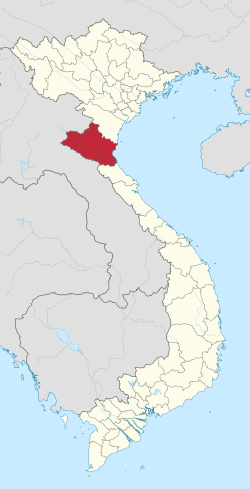Nghệ An
|
Nghệ An Province Tỉnh Nghệ An |
|
|---|---|
| Province | |
 Location of Nghệ An within Vietnam |
|
| Coordinates: 19°20′N 104°50′E / 19.333°N 104.833°ECoordinates: 19°20′N 104°50′E / 19.333°N 104.833°E | |
| Country |
|
| Region | North Central Coast |
| Capital | Vinh |
| Government | |
| • People's Council Chair | Trần Hồng Châu |
| • People's Committee Chair | Nguyen Duc Vinh |
| Area | |
| • Total | 16,490.0 km2 (6,366.8 sq mi) |
| Population (2014) | |
| • Total | 3,037,400 |
| • Density | 180/km2 (480/sq mi) |
| Demographics | |
| • Ethnicities | Vietnamese, Khơ Mú, Thai, Thổ, H'Mông |
| Time zone | ICT (UTC+7) |
| Area codes | 238 |
| ISO 3166 code | VN-22 |
| Website | www |
Nghệ An (Vietnamese: [ŋêˀ ʔaːn]) is a province in the North Central Coast region of Vietnam. It is Vietnam's largest province by area. Nghe An is located in latitude 180 33 'to 200 01' north latitude, longitude 1030 52 'to 1050 48' east longitude, in the central position of North Central of Vietnam. The east borders the sea, the west is bordered by the Lao PDR, the south borders Ha Tinh province, the north is Thanh Hoa province. Located in the east-west economic corridor connecting Myanmar - Thailand - Laos - Vietnam along Highway 7 to Cua Lo port. Nghe An has one city, three towns and 17 districts. In particular, Vinh City is a grade 1 city, the economic and cultural center of the province and the whole North Central Region. See Vinh more details.
Nghệ An () and Thanh Hoá were the base of "Thanh-Nghệ" (from the name of the two provinces) former Lê Dynasty loyalist opposition to the new Mạc dynasty in the 1530s.
Nghệ An is subdivided into 21 district-level sub-divisions:
They are further subdivided into 17 commune-level towns (or townlets), 431 communes, and 32 wards.
Nghe An has a total forest land area of 972,910.52 ha. Of which, production forest is 501,634.85 hectares, protection forest is 302,068.47 hectares, special-use forest is 169,207.2 hectares. With a total reserve of about 50 million cubic meters, over 1,000 million of bamboo trees are a significant source of raw materials for forestry exploitation and the development of forest-based industries. Nghe An has 82 km long coastline with an area of 4,230 nautical miles per square foot, along the coast has 6 creeks, over 3,000 ha of saltwater and brackish water, and 12,000 ha of freshwater and brackish water surface. Aquaculture development and processing. Nghe An has a large reserves of some minerals, especially minerals used for the production of construction materials such as limestone for cement production of nearly 4 billion tons; White limestone over 900 million tons; Clay for cement materials is over 1.2 billion tons; Clay for high-grade ceramics 5 million m3; Construction stone of 500 million m3; Basalt rock 260 million m3; Paving stones: Granite: 150 million m3, Mable 300 million m3, etc.
Nghe An has six national highways running through the province (NH 1A, NH 15, NH Ho Chi Minh, NH7, NH46, NH48); There is a trans-Asia route from Laos through Thanh Thuy border gate to Cua Lo and Dong Hoi port, along with provincial and district roads to create an interconnected network linking districts and economic zones. Province together and spread out the country as well as countries in the region. - Nghe An has Cua Lo port with the capacity of 3 million tons / year, capable of accommodating 10,000 DWT vessels. Currently, Cua Lo deep-water port has been planned and is being built to accommodate ships of 50,000 DWT- 100,000 DWT. In addition, Dong Hoi dedicated port is being built and capable of receiving 30.000 - 50.000 DWT vessels.
...
Wikipedia
